Songpyeon, half-moon shaped rice cake, is a must-have Chuseok delicacy.Thesweet, earthy flavor of beets, and their vibrant red color works beautifully with the songpyeon dough.


The weather has cooled down, the trees are changing colors, and the persimmons in my backyard are ripening. I absolutely love this time of year! Over the last couple of days, Koreans have been celebrating Chuseok (추석). Also referred to as Hangawi (한가위), it’s a mid-autumn/harvest festival, which takes place on the 15th day of the 8th lunar month.
Families gather, give thanks to their ancestors, and enjoy a great time together sharing abundant foods. As the old Korean saying goes, “No more, no less, just be like Hangawi”! Enjoy this beautiful, bountiful season!


Songpyeon (송편), aka half-moon shaped rice cake, is a must-have Chuseok delicacy. Ipreviously posted my songpyeonrecipe with several natural food coloring options. Here’s another option for you!
I love the sweet, earthy flavor of beets, and their vibrant red color works beautifully with the songpyeon dough. The first photo above also has plain white songpyeon without any food coloring.
The decorations are optional with different color doughs in my other songpyeon recipe. Simply make tiny small balls by rolling the dough between your fingers and press gently to shape them.
In this updated recipe, I used beet boiled water to create natural red color. You can easily adjust the color by reducing the water more or less. If you like strong red color, you can use the beet puree by roasting it first in the oven and puree in a blender.
Songpyeon is stuffed with a sweet filling and traditionally steamed on a bed of pine needles, hence the name songpyeon (“song” in “songpyeon” means pine tree). I’m lucky to have quite a few pine trees in my backyard.


Which rice flour to use for songpyeon
More Chuseok holiday recipes:
Songpyeon
Modeumjeon (Fish, Shrimp and Zucchini Pan-fried in Egg Batter)
Galbijjim (Braised Short Ribs)
Japchae (Stir-Fried Starch Noodles with Vegetables)
Nokdujeon (Savory Mung Bean Pancakes)
Sanjeok (Skewered Rice Cake with Beef and Vegetables)
Radish Soup (Mu Guk/Moo Guk)
15 Chuseok Recipesfor more


Have you tried this beet songpyeon recipe? Please rate the recipe below and leave a comment! Stay in touch by following me on YouTube,Pinterest,Twitter,FacebookandInstagram.


Beet Songpyeon
Instructions
-
In a small sauce pan, boil 2 to 3 slices (about 1/4-inch thick) in 1 cup of water until the water is reduced to about a half.
-
Sift the rice powder into a bowl. Add 4 tablespoons of hot beet water, quickly stirring it in with a spoon. Add more beet water if the dough is too dry, 1 teaspoon at a time.
-
Knead, pressing and stretching with the heel of the hand. Fold and rotate the dough. Repeat the kneading process for 2 to 3 minutes. (If the dough sticks to your hands or the bowl after some kneading, it’s too wet. Add a little more rice powder. If the dough breaks easily or is too stiff, it’s too dry. Add more beet water, 1 teaspoon at a time.)
-
Cover the dough with plastic wrap or a damp towel. Let it rest for 20 to 30 minutes.
-
Roughly grind the sesame seeds in a grinder or blender. Add the sugar, honey, and pinch of salt. Mix well until the honey is evenly distributed.
-
To assemble, tear off a small piece of the dough enough to make a roughly 1-inch ball. Roll tightly between your palms to shape a ball.
-
Make a well in the ball by pressing into it with your thumb, and press outwards, with both of your thumbs, on the inside walls of the well to slightly expand the opening. Place 1/2 teaspoon of the filling in the well and press it down. Seal tightly by squeezing the edges together.
-
Boil water in a steamer. Place a thin layer of pine needles or a damp kitchen cloth on the steamer insert. Boil the water over high heat. When it starts to steam, place the rice cakes on the steamer insert without the pieces touching one another. Cover with a thin layer of pine needles, if available. Cover and steam for 20 minutes.
Notes
For more vibrant red color, you can roast a small beet in the oven (about 45 minutes at 400 °F), and purée in a blender as fine as possible. You’ll need about ⅓ cup. Heat the beet purée until hot in the microwave and add to the rice powder, quickly stirring it in with a spoon. Add a little hot water as necessary, 1 teaspoon at a time.


This recipe was originally posted in September 2015. I’ve updated it here with new photos and improvements to the recipe.


Songpyeon dough is made with short grain rice powder (쌀가루), NOT glutenous (sweet rice) powder (찹쌀가루). Traditionally, Korean home cooks soak short grain rice overnight, drain, and then take to a gristmill to get it ground into fine powder.
Here in the States, we can find bags of frozen wet rice powder for making rice cake (tteok) sold in the freezer section of Korean grocery stores. Processed dry rice flour will not work for songpyeon.
You can try making rice flour at home by soaking short grain rice over night, drain for hours, and then use a powerful blender, coffee grinder, or food processor to finely ground. The rice flour/batter may still come out a bit grainy, not as soft.